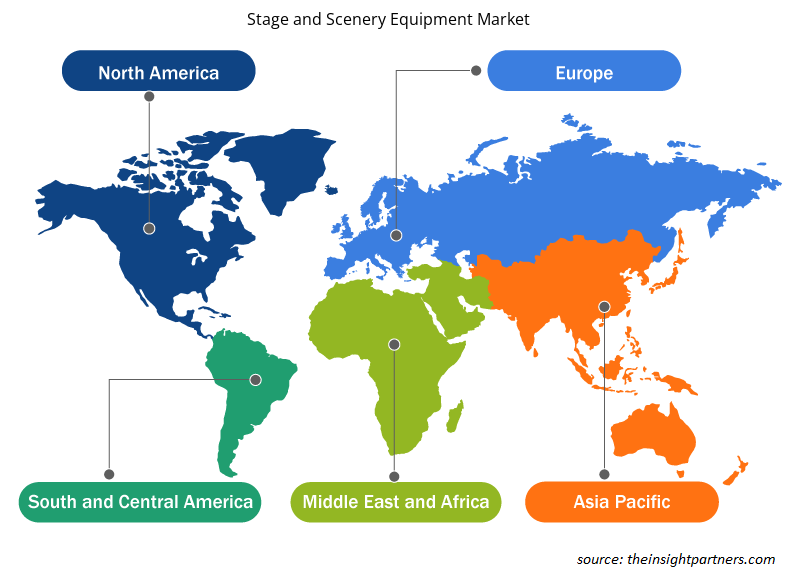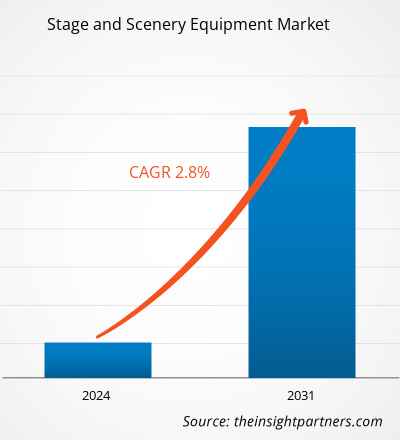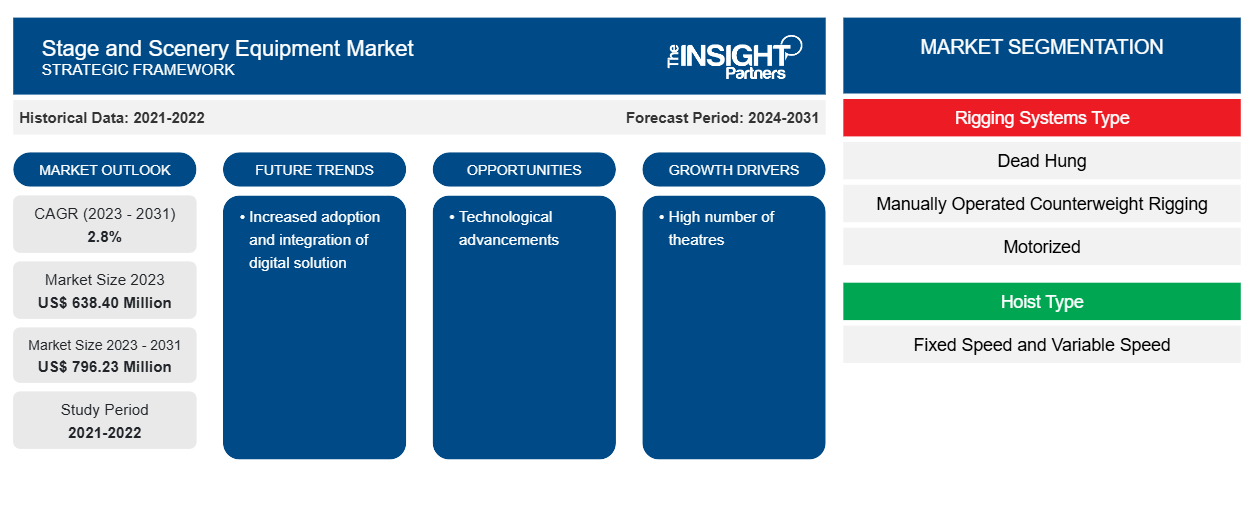Se proyecta que el tamaño del mercado de equipos para escenarios y escenografía alcance los 796,23 millones de dólares estadounidenses en 2031, frente a los 638,40 millones de dólares estadounidenses en 2023. Se espera que el mercado registre una CAGR del 2,8 % entre 2023 y 2031. La mayor adopción de soluciones digitales e innovadoras por parte de los actores clave de la industria son algunas de las tendencias recientes en el mercado de equipos para escenarios y escenografía. Por ejemplo, WIcreations BVBA presentó su tecnología de escenario automatizada que permite al manipulador controlar de forma remota el polipasto, los elevadores y los cabrestantes, entre otros.
Análisis del mercado de equipos para escenarios y escenografía
El aumento del gasto en entretenimiento es uno de los factores impulsores notables para la industria de equipos de escenarios y escenografía. Según el estudio realizado por la Asociación Estadounidense del Automóvil en 2024, aproximadamente el 37% y el 39% de los viajeros de la Generación Z y los millennials han gastado aproximadamente entre 500 y 5000 dólares estadounidenses en eventos en vivo organizados en distintos lugares. Además, según los datos publicados por Live Nation Entertainment, una destacada empresa de venta de entradas, los ingresos anuales en 2023 experimentaron un crecimiento del 36%. Además, según la empresa, 2023 fue el año más grande de la historia en comparación con los años recientes, ya que Ticketmaster vendió aproximadamente 620 millones de entradas. Este crecimiento muestra un aumento del gasto en la industria del entretenimiento y un número creciente de conciertos y salas de cine, entre otros. Un mayor número de estos modos de entretenimiento está impulsando directamente el crecimiento de la demanda de equipos de escenarios y escenografía.
Descripción general del mercado de equipos para escenarios y escenografía
La región de América del Norte es una de las regiones más destacadas en el mercado mundial de equipos para escenarios y escenografía. Uno de los principales factores detrás del crecimiento del mercado es la gran cantidad de clubes; los salones de baile son numerosos en los EE. UU. Este país es uno de los principales países con el mayor número de clubes nocturnos de primer nivel en 2023. Según los datos disponibles en el dominio público, hay aproximadamente más de 60.000 clubes nocturnos en los EE. UU. Por lo tanto, con una cantidad tan alta de lugares de entretenimiento en América del Norte, la demanda de equipos para escenarios y escenografía es alta. Sin embargo, se espera que la tasa de crecimiento de los equipos para escenarios y escenografía en la región de América del Norte se reduzca durante el período de pronóstico.
Personalice este informe según sus necesidades
Obtendrá personalización en cualquier informe, sin cargo, incluidas partes de este informe o análisis a nivel de país, paquete de datos de Excel, así como también grandes ofertas y descuentos para empresas emergentes y universidades.
-
Obtenga las principales tendencias clave del mercado de este informe.Esta muestra GRATUITA incluirá análisis de datos, desde tendencias del mercado hasta estimaciones y pronósticos.
Factores impulsores y oportunidades del mercado de equipos para escenarios y escenografía
El elevado número de teatrostheatres
A medida que el ingreso disponible del consumidor aumentó debido a la industrialización y la urbanización, el gasto en la industria del entretenimiento aumentó notablemente. Por lo tanto, debido al aumento del gasto, el número de teatros y otros lugares de entretenimiento aumentó notablemente. Según los datos disponibles de dominio público, había aproximadamente más de 5000 teatros solo en los EE. UU. Además, en muchas economías en desarrollo, el número de teatros aumentó rápidamente. Según los datos, las salas de cine en la India experimentaron un crecimiento de aproximadamente el 6% en 2023 con respecto a 2022.theatres and other entertainment places increased notably. As per the data available in the public domain, there were approximately more than 5000 theatres in the US alone. In addition, in many developing economies the number of theatres increased rapidly. As per the data the movie theatres in India witnessed growth of approximately 6% in 2023 from 2022.
Avances tecnológicos
A medida que la tecnología avanza, los consumidores buscan experiencias inmersivas e interactivas. Por ello, los fabricantes del sector están desarrollando soluciones innovadoras para ofrecer experiencias únicas a sus consumidores. La integración de sistemas de rigging con tecnología interactiva está aumentando notablemente. Este sistema ayuda a la iluminación reactiva y al movimiento interactivo de pantallas, entre otros. Se prevé que estos sistemas de integración generen oportunidades lucrativas para el mercado de equipos de escenarios y escenografía en los próximos años.
Análisis de segmentación del informe de mercado de equipos de escenario y escenografía
Los segmentos clave que contribuyeron a la derivación del análisis del mercado de equipos para escenarios y escenografía son el tipo, la causa, el tipo de trastorno, la categoría y el usuario final.
- Según el tipo de sistema de aparejo, el mercado de equipos para escenarios y escenografía se divide en aparejos suspendidos, aparejos con contrapeso operados manualmente y aparejos motorizados. El segmento de aparejos con contrapeso operados manualmente tuvo una mayor participación de mercado en 2023.
- Por tipo de polipasto, el mercado se segmenta en velocidad fija y velocidad variable. El segmento de velocidad variable tuvo la mayor participación del mercado en 2023.
- En términos de aplicación, el mercado se divide en teatros, clubes, conciertos, espectáculos corporativos, salones de baile y otros. El segmento de teatro dominó el mercado en 2023.
Análisis de la cuota de mercado de equipos de escenario y escenografía por geografía
El alcance geográfico del informe de mercado de equipos para escenarios y escenografía se divide principalmente en cinco regiones: América del Norte, Asia Pacífico, Europa, Medio Oriente y África, y América del Sur/América del Sur y Central.
La región de Asia Pacífico dominó el mercado mundial de equipos para escenarios y escenografía. El mercado de Asia Pacífico se clasifica además en función de Australia, China, India, Corea del Sur, Japón y el resto de Asia Pacífico. En países como China e India, donde la población es alta, la demanda de teatros y clubes también es alta. Según los datos proporcionados por la Federación de Cine de la India, el número de teatros en la India alcanzó los 10.000. Esto muestra una mayor demanda de sistemas de montaje en Asia Pacífico.
Perspectivas regionales del mercado de equipos para escenarios y escenografía
Los analistas de Insight Partners explicaron en detalle las tendencias y los factores regionales que influyen en el mercado de equipos para escenarios y escenografía durante el período de pronóstico. Esta sección también analiza los segmentos y la geografía del mercado de equipos para escenarios y escenografía en América del Norte, Europa, Asia Pacífico, Oriente Medio y África, y América del Sur y Central.

- Obtenga datos regionales específicos para el mercado de equipos de escenario y escenografía
Alcance del informe de mercado de equipos para escenarios y escenografía
| Atributo del informe | Detalles |
|---|---|
| Tamaño del mercado en 2023 | US$ 638,40 millones |
| Tamaño del mercado en 2031 | US$ 796,23 millones |
| CAGR global (2023 - 2031) | 2,8% |
| Datos históricos | 2021-2022 |
| Período de pronóstico | 2024-2031 |
| Segmentos cubiertos |
Por tipo de sistema de aparejo
|
| Regiones y países cubiertos |
América del norte
|
| Líderes del mercado y perfiles de empresas clave |
|
Densidad de actores del mercado: comprensión de su impacto en la dinámica empresarial
El mercado de equipos para escenarios y escenografía está creciendo rápidamente, impulsado por la creciente demanda de los usuarios finales debido a factores como la evolución de las preferencias de los consumidores, los avances tecnológicos y una mayor conciencia de los beneficios del producto. A medida que aumenta la demanda, las empresas amplían sus ofertas, innovan para satisfacer las necesidades de los consumidores y aprovechan las tendencias emergentes, lo que impulsa aún más el crecimiento del mercado.
La densidad de actores del mercado se refiere a la distribución de las empresas o firmas que operan dentro de un mercado o industria en particular. Indica cuántos competidores (actores del mercado) están presentes en un espacio de mercado determinado en relación con su tamaño o valor total de mercado.
Las principales empresas que operan en el mercado de equipamiento escénico y escenográfico son:
- Tecnología de protección
- Trabajo de tracción
- Controles de teatro electrónicos (ETC) Conecta
- Polipasto eZ
- Compañía: JR Clancy, Inc.
- Producción de montaña inc.
Descargo de responsabilidad : Las empresas enumeradas anteriormente no están clasificadas en ningún orden particular.

- Obtenga una descripción general de los principales actores clave del mercado de equipos para escenarios y escenografía
Noticias y desarrollos recientes del mercado de equipos para escenarios y escenografía
El mercado de equipos para escenarios y escenografía se evalúa mediante la recopilación de datos cualitativos y cuantitativos posteriores a la investigación primaria y secundaria, que incluye publicaciones corporativas importantes, datos de asociaciones y bases de datos. A continuación, se incluye una lista de los avances en el mercado de los trastornos del habla y el lenguaje y las estrategias:
- Wenger Corporation presentó el nuevo polipasto PowerLift de JR Clancy, un polipasto Powerlite. El nuevo polipasto tiene un diseño de detección de carga mejorado y viene con una viga continua opcional. (Fuente: Wenger Corporation, comunicado de prensa/sitio web de la empresa/boletín informativo, 20XX)
- HARMAN Professional Solutions, líder mundial en sistemas de audio, iluminación, video y control, anunció su Martin MAC Viper XIP, el dispositivo de última generación de la clase Viper que integra el rendimiento icónico de Viper, la tecnología de resistencia a la intemperie XIP de Martin (pendiente de patente) y el conjunto de características más robusto. (Fuente: Nombre de la empresa de equipos para escenarios y escenografía, comunicado de prensa/sitio web de la empresa/boletín informativo, 2024)
Informe de mercado sobre equipos para escenarios y escenografía: cobertura y resultados
El informe “Tamaño y pronóstico del mercado de equipos para escenarios y escenografía (2021-2031)” proporciona un análisis detallado del mercado que cubre las siguientes áreas:
- Tamaño del mercado y pronóstico a nivel global, regional y nacional para todos los segmentos clave del mercado cubiertos bajo el alcance
- Dinámica del mercado, como impulsores, restricciones y oportunidades clave
- Principales tendencias futuras
- Análisis detallado de las cinco fuerzas de Porter y PEST y FODA
- Análisis del mercado global y regional que cubre las tendencias clave del mercado, los principales actores, las regulaciones y los desarrollos recientes del mercado.
- Análisis del panorama de la industria y de la competencia que abarca la concentración del mercado, el análisis de mapas de calor, los actores destacados y los desarrollos recientes
- Perfiles detallados de empresas
- Análisis histórico (2 años), año base, pronóstico (7 años) con CAGR
- Análisis PEST y FODA
- Tamaño del mercado, valor/volumen: global, regional y nacional
- Industria y panorama competitivo
- Conjunto de datos de Excel
Informes recientes
Testimonios
Razón para comprar
- Toma de decisiones informada
- Comprensión de la dinámica del mercado
- Análisis competitivo
- Información sobre clientes
- Pronósticos del mercado
- Mitigación de riesgos
- Planificación estratégica
- Justificación de la inversión
- Identificación de mercados emergentes
- Mejora de las estrategias de marketing
- Impulso de la eficiencia operativa
- Alineación con las tendencias regulatorias























 Obtenga una muestra gratuita para - Mercado de equipos para escenarios y escenografía
Obtenga una muestra gratuita para - Mercado de equipos para escenarios y escenografía